Electric Vehicle Fleet Management for a Prosumer Building with Renewable Generation
Abstract
:1. Introduction
2. Materials and Methods
2.1. System Description and Input Data
- The number of RES power plants, indicated by J;
- The number of EVS, which coincides with the number of charging points, denoted as N;
- The size [kVA] of the inverter associated with the j-th RES plant;
- The estimated average power [kW] that can be generated by the j-th RES plant at time t;
- the curtailment cost [EUR/kWh] of the j-th RES plant, represented by its Levelized Cost of Electricity (LCOE);
- The rated capacity [kWh] of the battery installed inside the n-th EV, together with its minimum state of charge [%];
- The average energy consumption [kWh/km] of the n-th EV;
- The transportation demand of the n-th EV in the time interval t, measured in [km];
- Information on the presence of the vehicles at the facility, as expressed by the factor , which is equal to 1 when the n-th EV can be connected to its charging point and equal to 0 when the vehicle is not present;
- The minimum power [kW] that can be delivered to the n-th EV;
- The maximum power [kW] that can be delivered to the n-th EV;
- The minimum power [kW] that can be supplied by the n-th EV when it is operated in V2B mode;
- The maximum power [kW] that can be supplied by the n-th EV when it is operated in V2B mode;
- The charging ( and discharging ( efficiencies of EVs;
- The electrical load profiles of the building, in terms of active () [kW] and inductive reactive power () [kVAr];
- The size [kVA] of the transformer which connects the microgrid to the medium voltage distribution network;
- The active energy purchase and selling prices, respectively, [EUR/kWh] and [EUR/kWh];
- The penalty [EUR/kVArh] on reactive energy absorbed from the distribution network, as set by the authority.
2.2. Mathematical Model
- [kW]: generated active power;
- [kW]: curtailed active power;
- [kVAr]: inductive reactive power absorbed from the microgrid;
- [kVAr]: inductive reactive power supplied to the microgrid.
- [kW]: active power withdrawn from the distribution network;
- [kW]: active power injected into the distribution network;
- [kVAr]: inductive reactive power absorbed from the distribution network.
- [kVAr]: inductive reactive power provided to the distribution network.
- [kW]: active power supplied to the n-th EV;
- [kW]: active power provided by the n-th EV when operated in V2B mode;
- [kWh]: energy content of the battery in the n-th EV.
3. Results
3.1. Assumptions
- has been set equal to 0.40 [EUR/kWh] during peak hours and equal to 0.27 [EUR/kWh] during off-peak hours, pre-holiday days and holidays;
- has been set equal to 0.0027 [EUR/kVArh] for the whole year;
- has been set equal to 0.20 [EUR/kWh] for the whole year.
3.2. EMS Results: Sensitivity on the Number of EDVs
3.3. Comparison of EMS Results Taking into Account Forecasting Uncertainty
3.4. Comparison of EMS Results for Different Typical Days
4. Conclusions
Author Contributions
Funding
Data Availability Statement
Conflicts of Interest
References
- IEA. Buildings; IEA: Paris, France, 2022. [Google Scholar]
- Renovation Wave: Creating Green Buildings for the Future. Available online: https://europa.eu/!bG4m7p (accessed on 16 June 2023).
- Fit for 55: Why the EU Is Toughening CO2 Emission Standards for Cars and Vans. Available online: https://europa.eu/!w39R7x (accessed on 16 June 2023).
- Fiaschi, D.; Bandinelli, R.; Conti, S. A case study for energy issues of public buildings and utilities in a small municipality: Investigation of possible improvements and integration with renewables. Appl. Energy 2012, 97, 101–114. [Google Scholar] [CrossRef]
- Alshahrani, A.; Omer, S.; Su, Y.; Mohamed, E.; Alotaibi, S. The technical challenges facing the integration of small-scale and large-scale PV systems into the grid: A critical review. Electronics 2019, 8, 1443. [Google Scholar] [CrossRef]
- Walker, S.L. Building mounted wind turbines and their suitability for the urban scale—A review of methods of estimating urban wind resource. Energy Build. 2011, 43, 1852–1862. [Google Scholar] [CrossRef]
- Gautier, A.; Jacqmin, J.; Poudou, J.-C. The prosumers and the grid. J. Regul. Econ. 2018, 53, 100–126. [Google Scholar] [CrossRef]
- Lopez, A.; Ogayar, B.; Hernández, J.; Sutil, F. Survey and assessment of technical and economic features for the provision of frequency control services by household-prosumers. Energy Policy 2020, 146, 111739. [Google Scholar] [CrossRef]
- Parag, Y.; Sovacool, B.K. Electricity market design for the prosumer era. Nat. Energy 2016, 1, 16032. [Google Scholar] [CrossRef]
- Lavi, Y.; Apt, J. Using PV inverters for voltage support at night can lower grid costs. Energy Rep. 2022, 8, 6347–6354. [Google Scholar] [CrossRef]
- Talkington, S.; Grijalva, S.; Reno, M.J.; Azzolini, J.A. Solar PV inverter reactive power disaggregation and control setting estimation. IEEE Trans. Power Syst. 2022, 37, 4773–4784. [Google Scholar] [CrossRef]
- Piazza, G.; Bracco, S.; Delfino, F.; Siri, S. Optimal design of electric mobility services for a Local Energy Community. Sustain. Energy Grids Netw. 2021, 26, 100440. [Google Scholar] [CrossRef]
- Ioakimidis, C.; Thomas, D.; Rycerski, P.; Genikomsakis, K. Peak shaving and valley filling of power consumption profile in non-residential buildings using an electric vehicle parking lot. Energy 2018, 148, 148–158. [Google Scholar] [CrossRef]
- Barone, G.; Buonomano, A.; Forzano, C.; Giuzio, G.F.; Palombo, A. Increasing self-consumption of renewable energy through the Building to Vehicle to Building approach applied to multiple users connected in a virtual micro-grid. Renew. Energy 2020, 159, 1165–1176. [Google Scholar] [CrossRef]
- Arias, N.B.; Hashemi, S.; Andersen, P.B.; Træholt, C.; Romero, R. Distribution system services provided by electric vehicles: Recent status, challenges, and future prospects. IEEE Trans. Intell. Transp. Syst. 2019, 20, 4277–4296. [Google Scholar] [CrossRef]
- Borge-Diez, D.; Icaza, D.; Açıkkalp, E.; Amaris, H. Combined vehicle to building (V2B) and vehicle to home (V2H) strategy to increase electric vehicle market share. Energy 2021, 237, 121608. [Google Scholar] [CrossRef]
- Martinenas, S.; Marinelli, M.; Andersen, P.B.; Træholt, C. Implementation and demonstration of grid frequency support by V2G enabled electric vehicle. In Proceedings of the 2014 49th International Universities Power Engineering Conference (UPEC), Cluj-Napoca, Romania, 2–5 September 2014; pp. 1–6. [Google Scholar]
- Meng, J.; Mu, Y.; Jia, H.; Wu, J.; Yu, X.; Qu, B. Dynamic frequency response from electric vehicles considering travelling behavior in the Great Britain power system. Appl. Energy 2016, 162, 966–979. [Google Scholar] [CrossRef]
- Aziz, M.; Oda, T.; Kashiwagi, T. Extended utilization of electric vehicles and their re-used batteries to support the building energy management system. Energy Procedia 2015, 75, 1938–1943. [Google Scholar] [CrossRef]
- Zhou, Y.; Cao, S.; Hensen, J.L.; Lund, P.D. Energy integration and interaction between buildings and vehicles: A state-of-the-art review. Renew. Sustain. Energy Rev. 2019, 114, 109337. [Google Scholar] [CrossRef]
- Zheng, S.; Huang, G.; Lai, A.C. Coordinated energy management for commercial prosumers integrated with distributed stationary storages and EV fleets. Energy Build. 2023, 282, 112773. [Google Scholar] [CrossRef]
- He, Z.; Khazaei, J.; Freihaut, J.D. Optimal integration of Vehicle to Building (V2B) and Building to Vehicle (B2V) technologies for commercial buildings. Sustain. Energy Grids Netw. 2022, 32, 100921. [Google Scholar] [CrossRef]
- Kelm, P.; Mieński, R.; Wasiak, I. Energy management in a prosumer installation using hybrid systems combining EV and stationary storages and renewable power sources. Appl. Sci. 2021, 11, 5003. [Google Scholar] [CrossRef]
- Rücker, F.; Schoeneberger, I.; Wilmschen, T.; Sperling, D.; Haberschusz, D.; Figgener, J.; Sauer, D.U. Self-sufficiency and charger constraints of prosumer households with vehicle-to-home strategies. Appl. Energy 2022, 317, 119060. [Google Scholar] [CrossRef]
- Thomas, D.; Deblecker, O.; Ioakimidis, C. Optimal operation of an energy management system for a grid-connected smart building considering photovoltaics’ uncertainty and stochastic electric vehicles’ driving schedule. Appl. Energy 2018, 210, 1188–1206. [Google Scholar] [CrossRef]
- Farinis, G.Κ.; Kanellos, F.D. Integrated energy management system for Microgrids of building prosumers. Electr. Power Syst. Res. 2021, 198, 107357. [Google Scholar] [CrossRef]
- Bracco, S.; Fresia, M. Energy Management System for the Optimal Operation of a Grid-Connected Building with Renewables and an Electric Delivery Vehicle. In Proceedings of the IEEE EUROCON 2023—20th International Conference on Smart Technologies, Torino, Italy, 6–8 July 2023; pp. 472–477. [Google Scholar]
- Lofberg, J. YALMIP: A toolbox for modeling and optimization in MATLAB. In Proceedings of the 2004 IEEE International Conference on Robotics and Automation (IEEE Cat. No. 04CH37508), Taipei, Taiwan, 2–4 September 2004; pp. 284–289. [Google Scholar]
- Šúri, M.; Huld, T.; Cebecauer, T.; Dunlop, E.D. Geographic aspects of photovoltaics in Europe: Contribution of the PVGIS web site. IEEE J. Sel. Top. Appl. Earth Obs. Remote Sens. 2008, 1, 34–41. [Google Scholar] [CrossRef]
- de Simón-Martín, M.; Bracco, S.; Piazza, G.; Pagnini, L.C.; González-Martínez, A.; Delfino, F. Application to Real Case Studies. In Levelized Cost of Energy in Sustainable Energy Communities: A Systematic Approach for Multi-Vector Energy Systems; Springer International Publishing: Cham, Switzerland, 2022; pp. 77–120. [Google Scholar] [CrossRef]
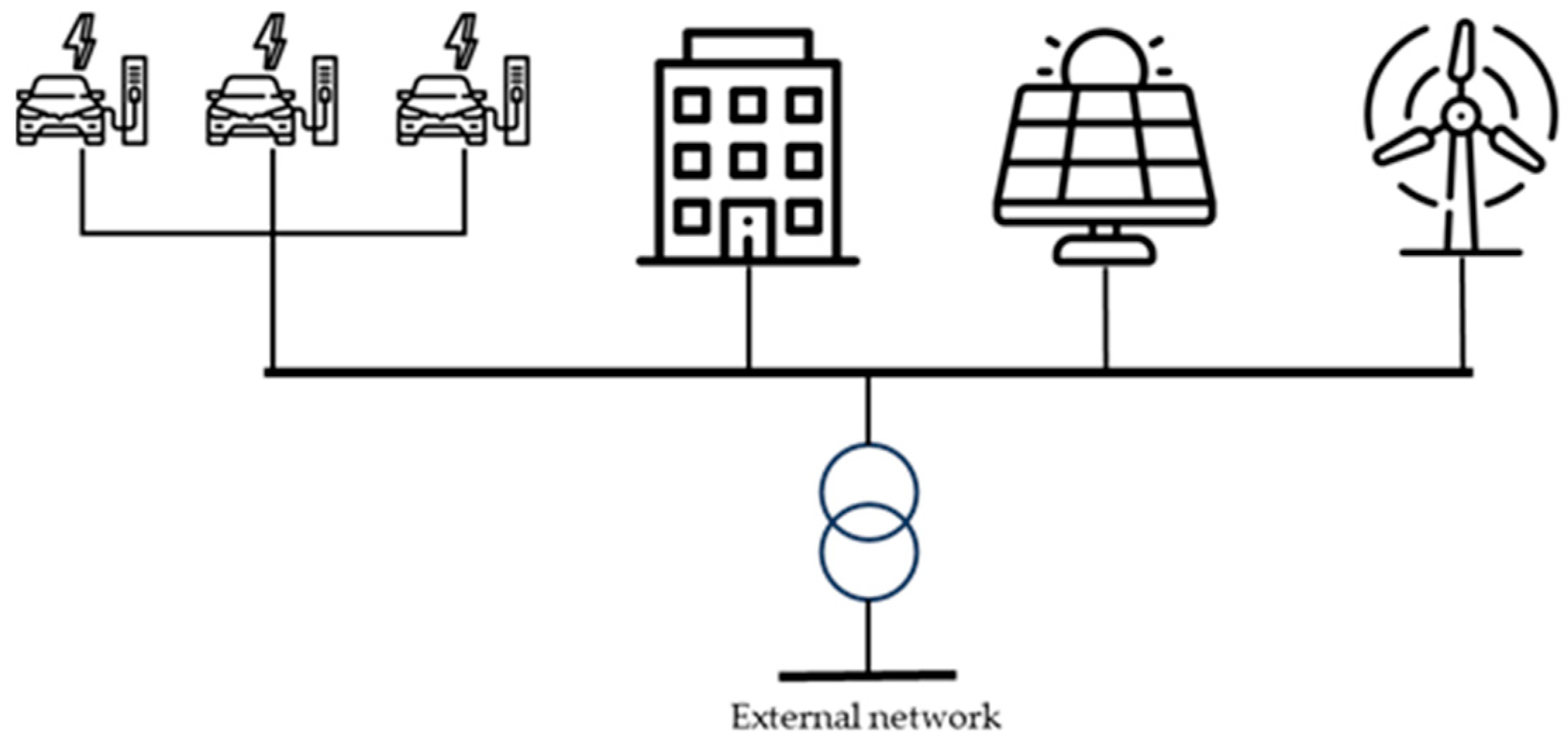
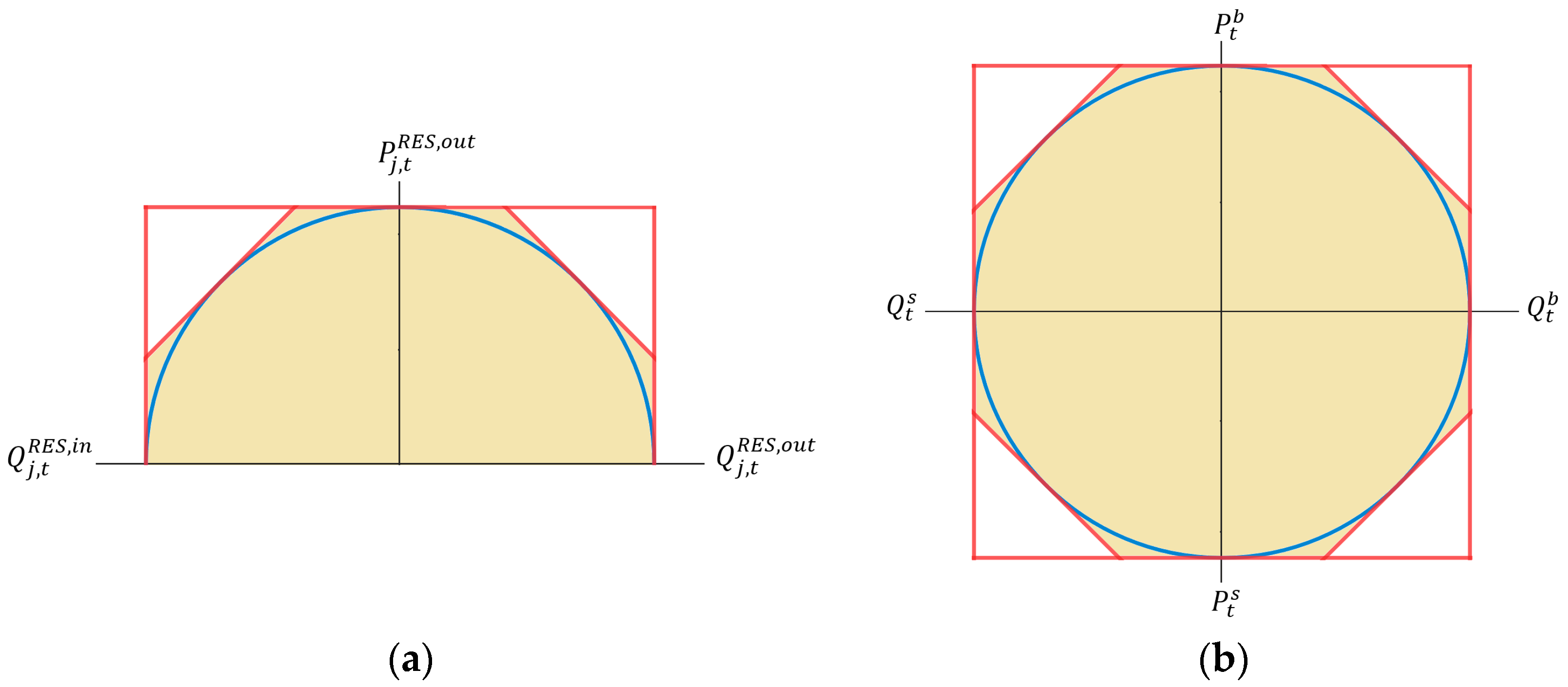

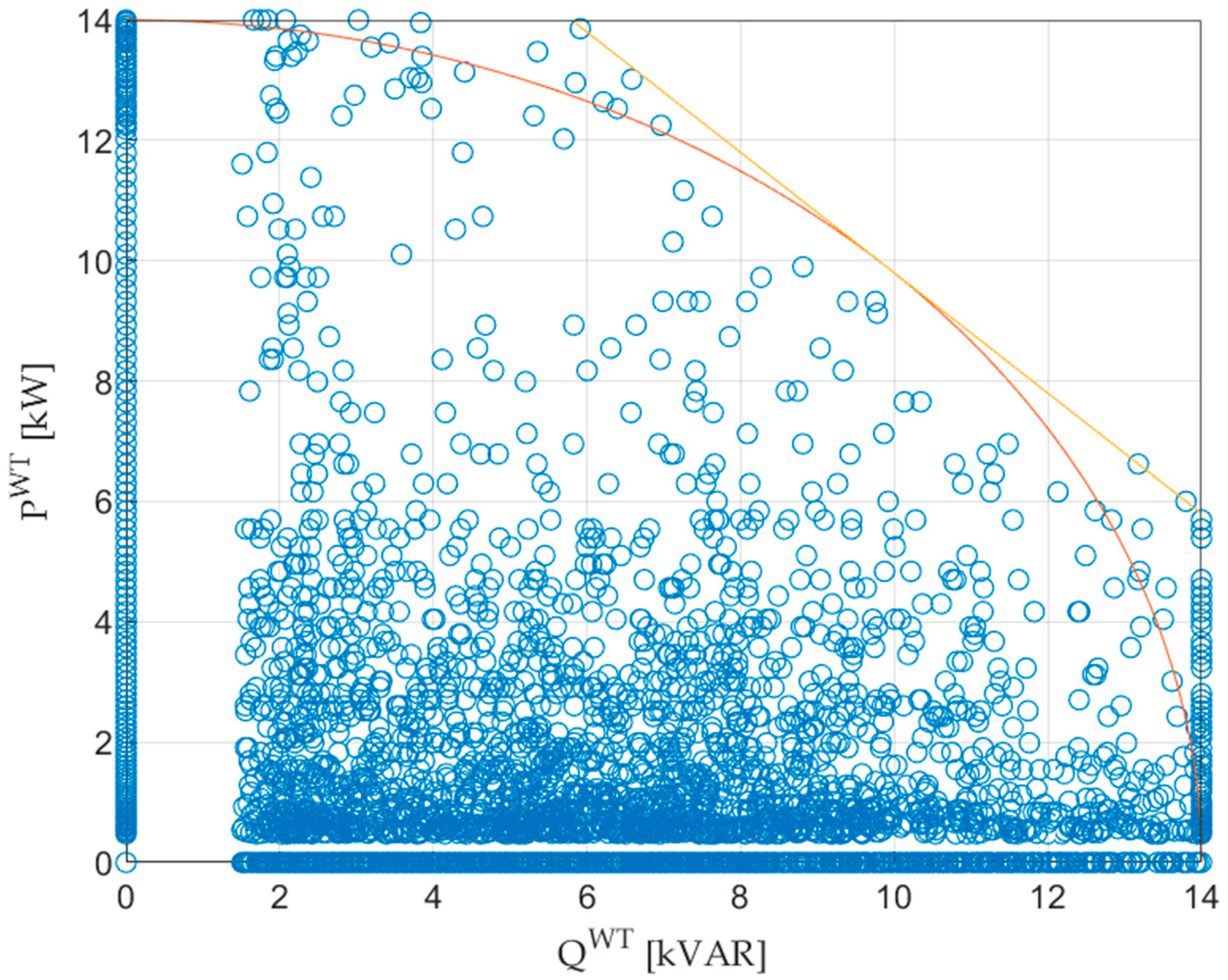
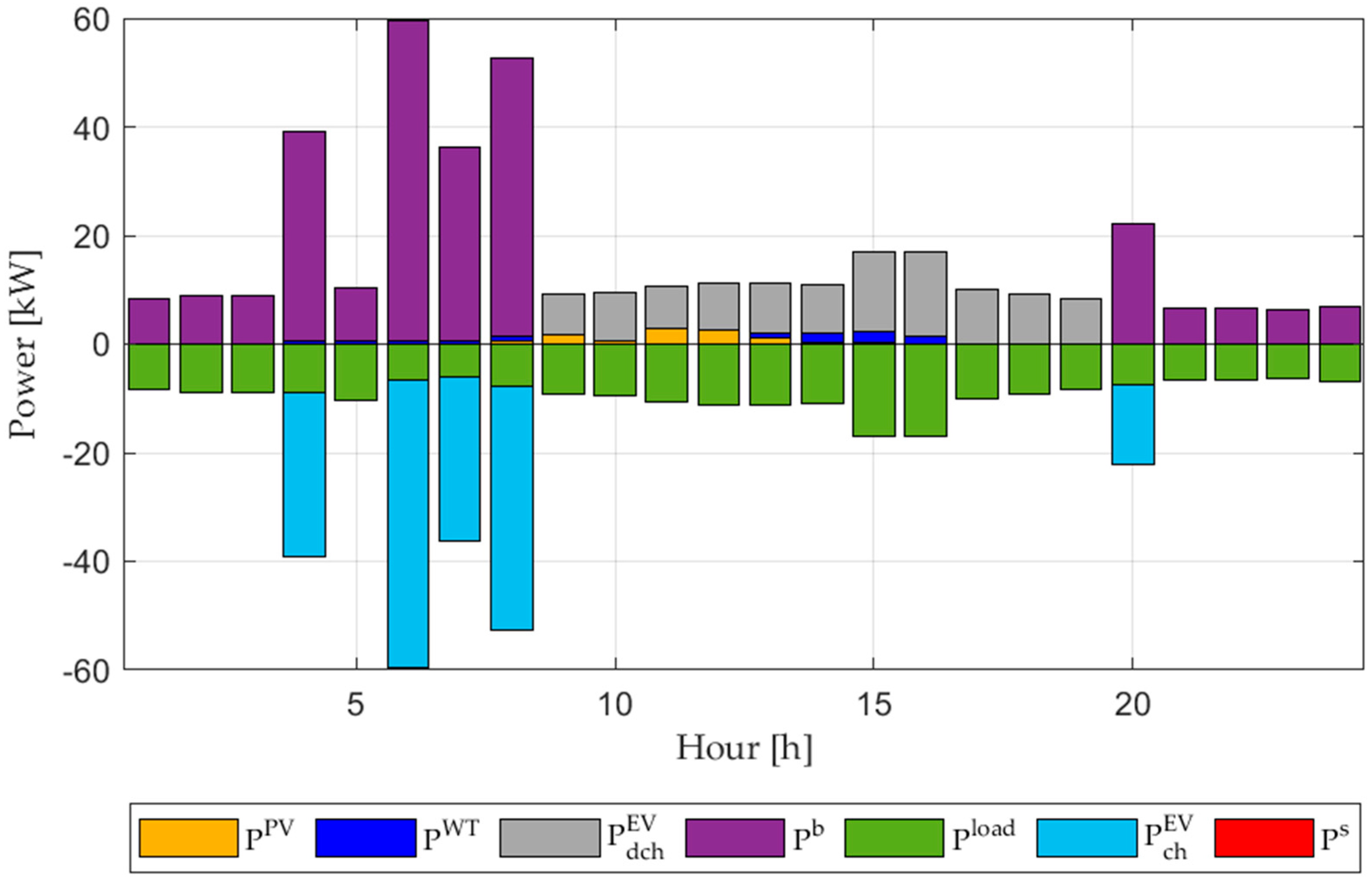
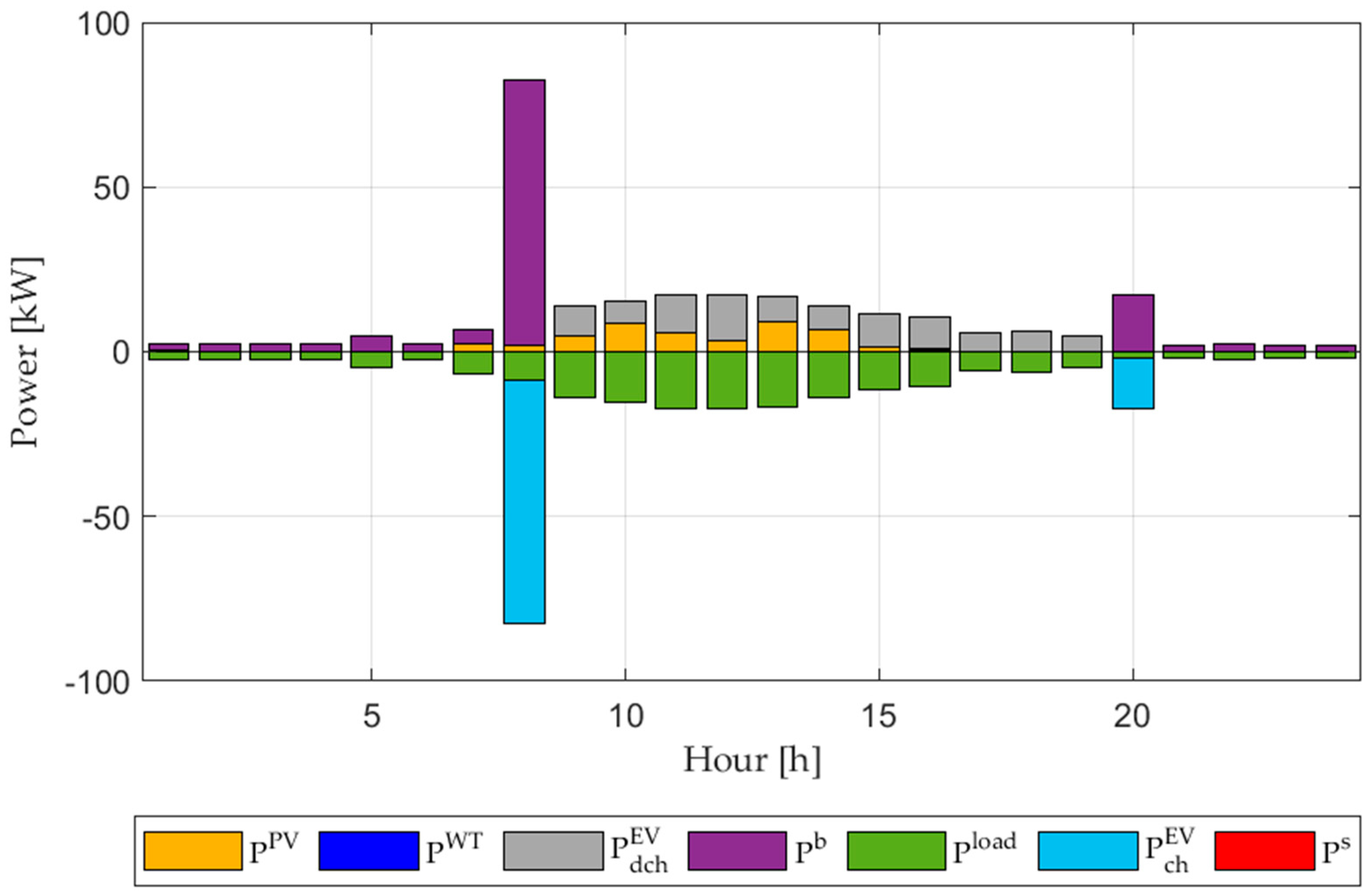
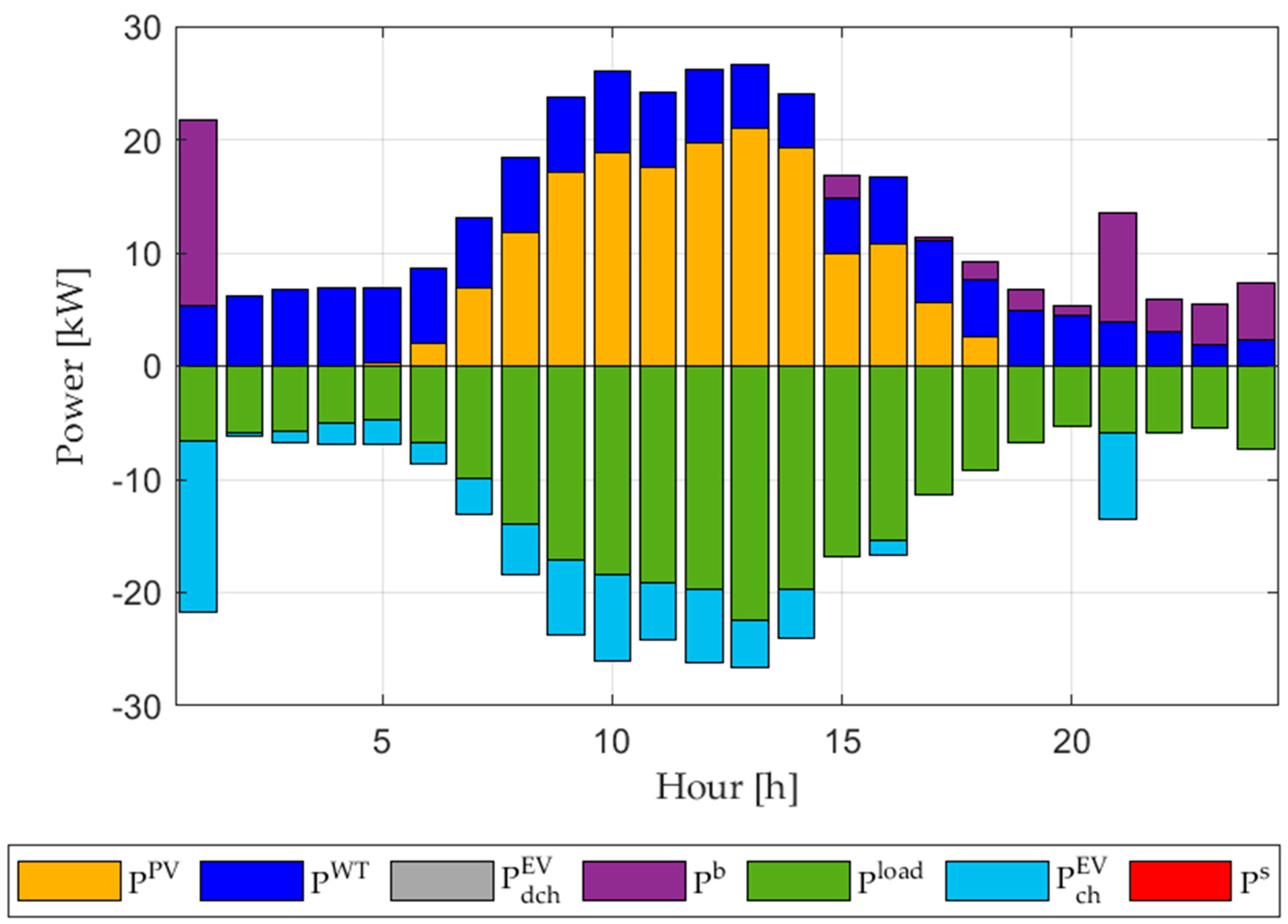

| High WT EOH | Low WT EOH | |
|---|---|---|
| High PV EOH | Scenario I | Scenario III |
| PV: 1415 h | PV: 1293 h | |
| WT: 1102 h | WT: 1102 h | |
| Low PV EOH | Scenario II | Scenario IV |
| PV: 1415 h | PV: 1293 h | |
| WT: 916 h | WT: 916 h |
| Working Days | Holidays | Preholiday Days | |
|---|---|---|---|
| EDV-I | 14.5 km | 0 km | 6.25 km |
| EDV-II | 21.75 km | 0 km | 9.375 km |
| Annual Energy | |
|---|---|
| Available from PV [kWh] | 39,102 |
| Available from WT [kWh] | 13,996 |
| Active power load [kWh] | 72,646 |
| Reactive power load [KVArh] | 72,157 |
| [-] | NEDV = 10 | NEDV = 50 | NEDV = 100 | |
|---|---|---|---|---|
| PV active energy generation | [kWh] | 39,102 | ||
| PV curtailed energy | [kWh] | 0 | ||
| PV reactive energy generation | [kVArh] | 44,654 | ||
| WT active energy generation | [kWh] | 13,996 | ||
| WT curtailed energy | [kWh] | 0 | ||
| WT reactive energy generation | [kVArh] | 27,503 | ||
| Bought active energy | [kWh] | 34,209 | 73,585 | 124,630 |
| Sold active energy | [kWh] | 14,604 | 0 | 0 |
| Bought reactive energy | [kVArh] | 0 | ||
| Energy charged to EDVs | [kWh] | 21,700 | 62,536 | 113,581 |
| Energy discharged from EDVs | [kWh] | 84,985 | ||
| NCs | [EUR] | 8944 | 19,868 | 33,650 |
| [-] | Scenario I | Scenario II | Scenario III | Scenario IV | |
|---|---|---|---|---|---|
| PV active energy generation | [kWh] | 41,046 | 41,046 | 37,507 | 37,507 |
| PV curtailed energy | [kWh] | 0 | 0 | 0 | 0 |
| PV reactive energy generation | [kVArh] | 43,601 | 42,850 | 45,753 | 44,837 |
| WT active energy generation | [kWh] | 15,424 | 12,820 | 15,424 | 12,820 |
| WT curtailed energy | [kWh] | 0 | 0 | 0 | 0 |
| WT reactive energy generation | [kVArh] | 28,556 | 29,307 | 26,402 | 27,321 |
| Bought active energy | [kWh] | 70,034 | 72,737 | 73,817 | 76,527 |
| Sold active energy | [kWh] | 0 | 0 | 0 | 0 |
| Bought reactive energy | [kVArh] | 0 | 0 | 0 | 0 |
| Energy charged to EDVs | [kWh] | 61,845 | 62,228 | 62,783 | 63,191 |
| Energy discharged from EDVs | [kWh] | 79,872 | 82,708 | 86,813 | 89,828 |
| NCs | [EUR] | 18,909 | 19,639 | 19,931 | 20,662 |
Disclaimer/Publisher’s Note: The statements, opinions and data contained in all publications are solely those of the individual author(s) and contributor(s) and not of MDPI and/or the editor(s). MDPI and/or the editor(s) disclaim responsibility for any injury to people or property resulting from any ideas, methods, instructions or products referred to in the content. |
© 2023 by the authors. Licensee MDPI, Basel, Switzerland. This article is an open access article distributed under the terms and conditions of the Creative Commons Attribution (CC BY) license (https://creativecommons.org/licenses/by/4.0/).
Share and Cite
Fresia, M.; Bracco, S. Electric Vehicle Fleet Management for a Prosumer Building with Renewable Generation. Energies 2023, 16, 7213. https://doi.org/10.3390/en16207213
Fresia M, Bracco S. Electric Vehicle Fleet Management for a Prosumer Building with Renewable Generation. Energies. 2023; 16(20):7213. https://doi.org/10.3390/en16207213
Chicago/Turabian StyleFresia, Matteo, and Stefano Bracco. 2023. "Electric Vehicle Fleet Management for a Prosumer Building with Renewable Generation" Energies 16, no. 20: 7213. https://doi.org/10.3390/en16207213






